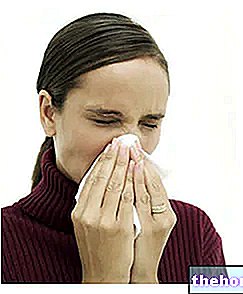Asthma
Parallel to the increasing rate of environmental pollution, asthmatic forms are constantly increasing. Asthmatic people become hypersensitive to stimuli of different nature (chemical, physical, thermal, allergenic), which are then the triggering cause of the asthmatic crisis.
Asthma is a chronic inflammation of the respiratory tract in which the bronchi are narrowed due to the presence of edema and, occasionally, due to spasmogenic substances released by local cells or by cells that infiltrate the bronchial level through the circulatory stream.
These substances, called spasmogens, are the mediators of bronchoconstriction and can cause an immediate or late asthmatic attack.
The main mediators of bronchoconstriction are histamine, prostanoids (thromboxanes and some prostaglandins), some leukotrienes (in particular cysteinyl leukotrienes), platelet activating factor (PAF) and some neuropeptides (some neurokinins).

Asthma Medications
Any drug capable of reducing bronchial inflammation or antagonizing the effects of reactions triggered by spasmogens is potentially an anti-asthmatic.
Anti-asthma drugs fall into several categories:
- Glucocorticoids
- Beta-2 Agonists
- Xanthine derivatives
- Benzopyranones
- Antimuscarinics
- Antileukotriene
Glucocorticoids
Glucocorticoids act indirectly by inhibiting the enzyme phospholipase A2 and, consequently, the formation of arachidonic acid and its subsequent conversion into leukotrienes and prostaglandins (substances with inflammatory activity).
They are also known as corticosteroids because they are normally produced by the adrenal cortex from cholesterol. The main hormone of the group is cortisol (or hydrocortisone).
Glucocorticoids are therefore able to reduce edema and the number of asthmatic attacks. The best known are flunisolide, administered by inhalation through self-dosed dispensers (250 µg per spray) and beclomethasone (Clenil ®) with a similar administration route ( 100, 200, 400 µg by spray) or by aerosol.
Aerosol drugs are often combined with a Beta-2 agonist to achieve a greater bronchodilator effect and are preferred by asthmatics when they have difficulty inhaling the drug orally or nasally.
Recourse to the administration of oral glucocorticoids (capsules, tablets) should only be done when results are not obtained by inhalation and for short periods of time, due to the rather evident side effects (greater susceptibility to infections, especially if of viral, widespread edema, then swelling, hypertension and bone demineralization).
Beta2-agonists
Beta2-agonist drugs are derivatives of norepinephrine, a hormone that acts on adrenergic receptors especially of the alpha and beta1 type, but little on B2 which are important for asthma, as, if stimulated, they cause a relaxation of the bronchial smooth muscle , with consequent dilation of the airways. It follows that any drug capable of enhancing the activity of these receptors, hence the name Beta2-agonists, is useful as an asthmatic.
The best known and most used is salbutamol (Ventolin ®) which, by inhalation (0.2 mg per spray), produces a "rapid action that lasts for about three hours. Salbutamol is also used to prevent asthma attacks in view of a physical effort, even if we remember that it is forbidden to healthy athletes (it is considered doping).
Salbutamol can also be used as an aerosol, systemically (2-4 mg tablets; cos 4-6 mg) or parenterally (0.5 mg ampoules). Systemic administration is used only when asthmatic crises are too frequent because, although selective enough for B2 receptors, it also maintains activity against B1 which, concentrated in the heart, when stimulated lead to an increase in heart rate (tachycardia ) becoming dangerous especially for heart patients (to learn more see: Clenbuterol).
Alongside salbutamol, there are other B2-agonist drugs with a longer duration of action and for this reason used in maintenance therapy and not in crises (which require a drug with a fast pharmacological activity). Among these we remember salmeterol (Aliflus ®, Serevent ®, Seretide ®) in doses of 0.25 mg per spray (to be inhaled once or twice in 24 hours, a single evening inhalation may also be sufficient).
Xanthine derivatives
The xanthine derivatives originate from theophylline or 1,3 dimethylxanthine, an analogue of caffeine present in tea and with a moderate bronchodilator activity. At therapeutic doses it is able to inhibit phosphodiesterases, enzymes that hydrolyze cyclic nucleotides. By doing so, theophylline increases the bioavailability of cyclic AMP which is a mediator of bronchial muscle relaxation.
At therapeutic doses, theophylline is not very soluble and for this reason salts are made by exploiting the acidic characteristics of the nitrogen present in position 7. The salt is obtained by associating two molecules of theophylline with one of ethylenediamine, obtaining aminophylline (in vials or in tablets, for a total of 200-300 mg / day and never at doses higher than 400 mg / day).
Aminophylline is a second or third choice anti-asthmatic that is used only when other drugs are not effective. At high doses it can induce vomiting, agitation, tachycardia, arrhythmia and become lethal.
Benzopyranones
Among the benzopiranones we remember chromoglycic acid, an antiallergic drug, which can also be used in the form of sodium salt. This medicine is used in some mild forms of allergies that can affect the eye, the nasal mucosa (rhinitis) or the bronchi; it is a first choice drug that is used at the first appearance of allergic symptoms, exclusively by inhalation, in the prevention of attacks (aerosols for children or inhalation sprays for children and adults). Among the anti-asthmatics it is the drug that gives absolutely the least side effects, but has a limited percentage efficacy (only 30-35% of patients find benefit from the use of this drug). The mechanism of action seems to be due to its ability to inhibit the release of spasmogens by the cells residing in the bronchi and also by those that reach it through the blood (it prevents the release of histamine).
Antimuscarinics
Antimuscarinics act by inhibiting the M3 muscarinic receptors for acetylcholine present in the bronchial area. This substance is in fact a neurotransmitter of the parasympathetic system which, by stimulating its muscarinic and nicotinic receptors, induces the contraction of skeletal and bronchial muscles. For this reason by blocking the muscarinic receptors of acetylcholine at the bronchial level, we obtain a bronchodilation useful for asthmatics. Atropine, an active ingredient obtained from Atropa belladonna, preferentially blocks the M1 and M2 receptors but not much the M3. Despite this it still has a slight bronchodilator activity, but it is little used because it leads to the functionality of the epithelial cilia of the airways (with consequent stagnation of mucus which in the asthmatic is already produced in abundance); the therapeutic effect is therefore scarcely evident.
On the other hand, ipratropium bromide (ATEM ®, BREVA ®) is an M2 and M3 antagonist, capable of bronchodilation without interfering with the activity of the eyelashes (in doses of 20 µg per spray). It is widely used in the presence of chronic obstructive pulmonary disease (COPD) - a disease characterized by chronic asthma, bronchitis and pulmonary emphysema -. Side effects are mostly limited to the appearance of dryness in the mouth and mucous membranes.
Antileukotriene
Antileukotrienics block the CYS and LT1 receptors present in the bronchial and lungs. In fact, their excessive stimulation by cystenilleukotrienes leads to a marked bronchospasm and inflammation of the bronchial mucosa. By blocking these receptors we will therefore obtain a "beneficial action for asthma patients."
Among the most known antileukotriene drugs we remember montelukast (SINGULAIR®), very important because it is able to reduce the number of asthmatic attacks and, gradually, bronchial edema. Its anti-inflammatory activity is however lower than that of corticosteroids, even if it is not it gives particularly serious side effects The antileukotrienics, very useful in the persistent therapy, are not suitable in the asthmatic crisis.
Other articles on "Antiasthmatic Drugs"
- Asthmatic Crises (Asthma Attacks)
- Asthma
- Asthma - Asthma Treatment Drugs
- Diet and Asthma
- Bronchial asthma
- Bronchial Asthma - Treatment, Drugs and Prevention
- Bronchial asthma - Herbal medicine























-nelle-carni-di-maiale.jpg)




